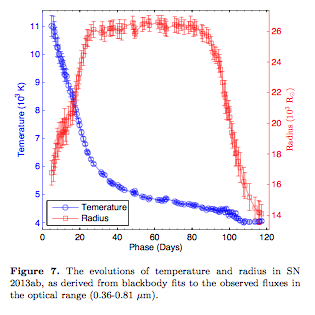Padova-Asiago Supernova Group
Highlights
SN 2013ab: a normal Type IIP supernova in NGC 5669
Bose, S. et al. 2015, MNRAS 450, 2373 (link to pdf)
We present densely sampled ultraviolet/optical photometric and low-resolution optical spectroscopic observations of the Type IIP supernova 2013ab in the nearby (about 24 Mpc) galaxy NGC 5669, from 2 to 190 d after explosion. Continuous photometric observations, with the cadence of typically a day to one week, were acquired with the 1-2 m class telescopes in the Las Cumbres Observatory Global Telescope network, ARIES telescopes in India and various other telescopes around the globe. The light curve and spectra suggest that the supernova (SN) is a normal Type IIP event with a plateau duration of 80 d with mid-plateau absolute visual magnitude of -16.7, although with a steeper decline during the plateau (0.92 mag 100 d-1 in V band) relative to other archetypal SNe of similar brightness. The velocity profile of SN 2013ab shows striking resemblance with those of SNe 1999em and 2012aw. Following the Rabinak & Waxman prescription, the initial temperature evolution of the SN emission allows us to estimate the progenitor radius to be 800 Rsun, indicating that the SN originated from a red supergiant star. The distance to the SN host galaxy is estimated to be 24.3 Mpc from expanding photosphere method. From our observations, we estimate that 0.064 Msun of 56Ni was synthesized in the explosion. General relativistic, radiation hydrodynamical modelling of the SN infers an explosion energy of 0.35 x10^51 erg, a progenitor mass (at the time of explosion) of 9 Msun and an initial radius of 600 Rsun. 52
Bose, S. et al. 2015, MNRAS 450, 2373 (link to pdf)
We present densely sampled ultraviolet/optical photometric and low-resolution optical spectroscopic observations of the Type IIP supernova 2013ab in the nearby (about 24 Mpc) galaxy NGC 5669, from 2 to 190 d after explosion. Continuous photometric observations, with the cadence of typically a day to one week, were acquired with the 1-2 m class telescopes in the Las Cumbres Observatory Global Telescope network, ARIES telescopes in India and various other telescopes around the globe. The light curve and spectra suggest that the supernova (SN) is a normal Type IIP event with a plateau duration of 80 d with mid-plateau absolute visual magnitude of -16.7, although with a steeper decline during the plateau (0.92 mag 100 d-1 in V band) relative to other archetypal SNe of similar brightness. The velocity profile of SN 2013ab shows striking resemblance with those of SNe 1999em and 2012aw. Following the Rabinak & Waxman prescription, the initial temperature evolution of the SN emission allows us to estimate the progenitor radius to be 800 Rsun, indicating that the SN originated from a red supergiant star. The distance to the SN host galaxy is estimated to be 24.3 Mpc from expanding photosphere method. From our observations, we estimate that 0.064 Msun of 56Ni was synthesized in the explosion. General relativistic, radiation hydrodynamical modelling of the SN infers an explosion energy of 0.35 x10^51 erg, a progenitor mass (at the time of explosion) of 9 Msun and an initial radius of 600 Rsun. 52
